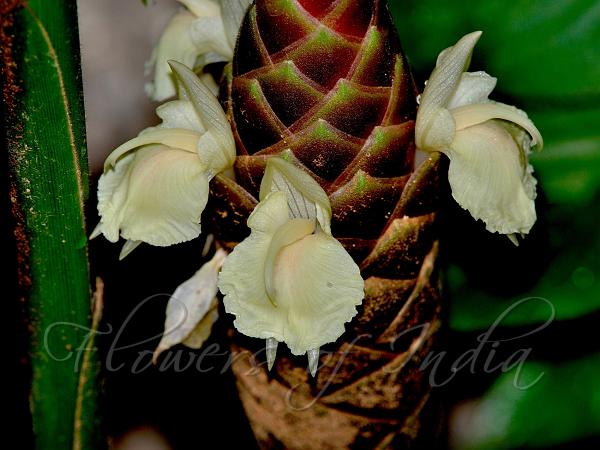|
| Cassumunar Ginger |
|

|

|
|
|
|
Photo: |
Botanical name: Zingiber purpureum Family: Zingiberaceae (Ginger family)
Synonyms: Zingiber cassumunar, Zingiber montanum auct. non (J.Koenig) Theilade
Synonyms: Zingiber cassumunar, Zingiber montanum auct. non (J.Koenig) Theilade
Cassumunar Ginger is a rhizome forming perennial herb,
with rather stout, leafy stem, up to 2 m high. Rhizome is yellow
inside, strongly aromatic. Leaves are lanceshaped, 30-45 cm long,
stalkless, velvet-hairy or velvet-hairy along midrib only on the lower
surface. Ligule 1 mm or less. Flowering stem arises from the root,
spikes purplish brown, 7-15 cm long, ovate to oblong on 15-30 cm long
flower-cluster-stalk. Flower are pale yellow, tube about 2.5 cm long.
Lip 3-lobed, pale yellow, mid-lobe nearly round, bifid.
Medicinal uses: It has a similar reputation to
the official ginger; used as a carminative and stimulant in diarrhoea
and colic. Tribal people of Chittagong Hill Tracts prescribe juice or
paste of the rhizome in flatulance. It is also given for cough and
headache. In Rajsthali, fresh juice is given to the female for the
treatment of amenorrhoea. Warmed leaves are applied over body to get
relief from pain. In Moheshkhali Island, cooked rhizome is given to
mothers after childbirth for quick recovery from weakness. Ethanolic
extract of the rhizome possesses wide range of significant
antibacterial and antifungal activities.
It has a similar reputation to
the official ginger; used as a carminative and stimulant in diarrhoea
and colic. Tribal people of Chittagong Hill Tracts prescribe juice or
paste of the rhizome in flatulance. It is also given for cough and
headache. In Rajsthali, fresh juice is given to the female for the
treatment of amenorrhoea. Warmed leaves are applied over body to get
relief from pain. In Moheshkhali Island, cooked rhizome is given to
mothers after childbirth for quick recovery from weakness. Ethanolic
extract of the rhizome possesses wide range of significant
antibacterial and antifungal activities.
Medicinal uses:
 It has a similar reputation to
the official ginger; used as a carminative and stimulant in diarrhoea
and colic. Tribal people of Chittagong Hill Tracts prescribe juice or
paste of the rhizome in flatulance. It is also given for cough and
headache. In Rajsthali, fresh juice is given to the female for the
treatment of amenorrhoea. Warmed leaves are applied over body to get
relief from pain. In Moheshkhali Island, cooked rhizome is given to
mothers after childbirth for quick recovery from weakness. Ethanolic
extract of the rhizome possesses wide range of significant
antibacterial and antifungal activities.
It has a similar reputation to
the official ginger; used as a carminative and stimulant in diarrhoea
and colic. Tribal people of Chittagong Hill Tracts prescribe juice or
paste of the rhizome in flatulance. It is also given for cough and
headache. In Rajsthali, fresh juice is given to the female for the
treatment of amenorrhoea. Warmed leaves are applied over body to get
relief from pain. In Moheshkhali Island, cooked rhizome is given to
mothers after childbirth for quick recovery from weakness. Ethanolic
extract of the rhizome possesses wide range of significant
antibacterial and antifungal activities. | Identification credit: Rushabh Chaudhari | Photographed in MNP Mumbai. |
• Is this flower misidentified? If yes,